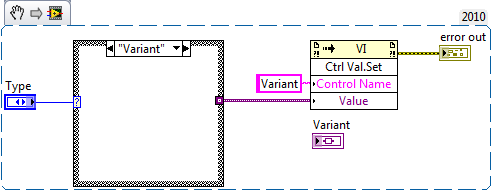
- #Labview invoke node serial number#
- #Labview invoke node pdf#
- #Labview invoke node code#
- #Labview invoke node download#
Does you program work as expected? Why/Why Not, any improvements that needs to be made with your program, etc. Finally, a brief summary/conclusion of your work.
#Labview invoke node code#
#Labview invoke node pdf#
What should you deliver? Only PDF File - No LabVIEW Code Make sure you fulfill all items in this Checklist (pdf) before you deliver your Report. You can use another template if you prefer. Here you find a Word Report Template you can use for your report. Submission: Document your LabVIEW Application (both GUI and code) and deliver a PDF (e.g, 4-7 pages). Please follow the LabVIEW Programming Guidelines (pdf) as shown and explained in this video: LabVIEW Programming Guidelines. Surprise me! Don't always go for the easy solution! Challenge yourself! Don't make the same application as everybody else in your class. Do it because you want to learn, not to satisfy my "requirements". Create something you are interested in and passionate about, in that way you learn so much more.

Using a state machine approach is a good way to make it right from the early beginning. The solution to this problem is organizing your code and data in a way that enables modularity, readability, and reuse. LabVIEW Applications: Typically engineers often create simple LabVIEW VIs that eventually grow out of control, because they don't have the proper structure and best practices. Read more (including downloading the LabVIEW Code) Perhaps you can get some ideas for your Delivery (see below)? Example 1ĭata Logging and Monitoring in LabVIEW Example (Video) Note! These videos are presented only to get you inspired, and to see what LabVIEW is capable of. To get an idea of what you can create with LabVIEW, see the following videos below.
#Labview invoke node serial number#
The Serial Number is provided by the LabVIEW responsible at your University/Workplace (assuming they have a valid license). You can use LabVIEW in Evaluation mode for some weeks, after that you will need a valid Serial Number.
#Labview invoke node download#
Open the links below in order to download LabVIEW:

Since LabVIEW is a full-blood programming language (in a graphical way), you can use LabVIEW for almost everything, personally I use LabVIEW for Datalogging and Monitoring, DAQ, Control Systems, OPC, Database Systems, SCADA Systems, Hardware in the Loop Simulations and Testing, Modbus, etc. LabVIEW is developed by National Instruments. Latest version of LabVIEW is LabVIEW 2020. LabVIEW is a graphical programming language, and it has powerful features for simulation, control and DAQ applications. Here you need to use the skills learned in Step 1.

Step 2 (Delivery Assignment): Solve the Delivery Assignment as described in the bottom of this web page.Step 1 (Preparations): Go through videos, resources, examples, and step by step exercises you find below in your own pace.Video: LabVIEW in Automation - Basic LabVIEW Programming


 0 kommentar(er)
0 kommentar(er)
